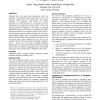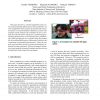HT
2003
ACM
14 years 5 months ago
2003
ACM
This paper addresses the problem of organizing material in mixed digital and physical environments. It presents empirical examples of how people use collectional artefacts and org...
CHI
2003
ACM
14 years 5 months ago
2003
ACM
Although there has been much speculation about the potential of Augmented Reality (AR), there are very few empirical studies about its effectiveness. This paper describes an exper...
ISWC
2003
IEEE
14 years 5 months ago
2003
IEEE
This paper describes a wearable augmented reality system using positioning infrastructures and a pedometer. To realize augmented reality systems, the position and orientation of u...
ISORC
2003
IEEE
14 years 5 months ago
2003
IEEE
The paper describes design and implementation of software infrastructure for building augmented reality applications for ubiquitous computing environments. Augmented reality is on...
ISMAR
2003
IEEE
14 years 5 months ago
2003
IEEE
This paper describes a Kalman filter design to estimate orientation of human body segments by fusing gyroscope, accelerometer and magnetometer signals. Ferromagnetic materials nea...
ISMAR
2003
IEEE
14 years 5 months ago
2003
IEEE
Current Augmented Reality (AR) applications require that the application software be written to support a specific AR interface set up. WireAR was developed to enable output from...
ISMAR
2003
IEEE
14 years 5 months ago
2003
IEEE
Research prototypes in AR usually do not emphasize software architecture. Nevertheless, their architecture is not arbitrary, but results from specific needs. Architectural approa...
ISMAR
2003
IEEE
14 years 5 months ago
2003
IEEE
This paper introduces a ”Diminished Reality” technique for removing an object or collection of objects and replacing it with an appropriate background image. Diminished Realit...
ISMAR
2003
IEEE
14 years 5 months ago
2003
IEEE
This paper describes a new hybrid tracking system that integrates standard outdoor augmented reality trackers with a low cost indoor tracker based on the use of fiducial markers. ...
ISMAR
2003
IEEE
14 years 5 months ago
2003
IEEE
We present a client/server implementation for running demanding mobile AR applications on a PDA device. The system incorporates various data compression methods to make it run as ...






